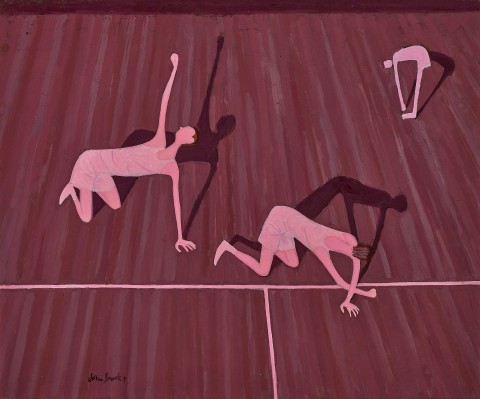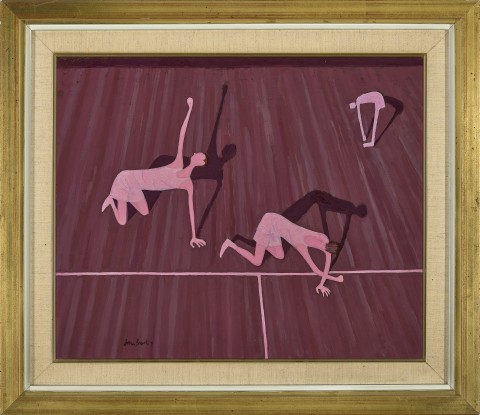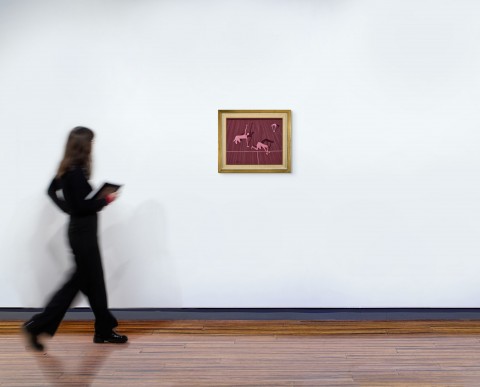THREE FIGURES, 1971
JOHN BRACK
oil on canvas on plywood
39.5 x 47.0 cm
signed and dated lower left: John Brack 71
inscribed with title verso: Three Figures
Joseph Brown Gallery, Melbourne
Private collection, Canberra, and the United Kingdom, acquired from the above in 1972
Thence by descent
Private collection, Sydney
Recent paintings by John Brack, Joseph Brown Gallery, Melbourne, 1 – 17 September 1971, cat. 14
Grishin, S., The Art of John Brack, Oxford University Press, Melbourne, 1990, vol. II, cat. o193, p. 27 (illus.)
Lindsay, R., John Brack: A Retrospective Exhibition, National Gallery of Victoria, Melbourne, 1987, p. 126
The following excerpts are from Grishin, S., The Art of John Brack, Oxford University Press, Melbourne, 1990, vol. I, pp. 121 – 22:
‘…The series of gymnasts of 1971 and 1972 consists of ten oil paintings and eight conté drawings. Thematically, it presents a logical progression from the ballroom dancing series – the concern with senseless ritual as recreational activities are converted into difficult and testing labour. In its formal language, however, there are signs of a fundamental change. A constant preoccupation in Brack’s art is identity. This can be traced back to a youthful interest in books on physiognomy as well as a later study of Nigel Dennis’ Cards of Identity with its questions of ‘re-identification’ and ‘personal distinctiveness’ ... Up to this point, Brack’s images of still-life objects – scissors, knives and forks – were kept separate from figure compositions, although he did imbue these still life objects with a symbolic existence. In the gymnast series, the stick-like figures start to lose a little of their human identity and increasingly become formal elements that symbolically convey humanity as observed from a distance. The whole setting is reduced to a minimum – the featureless floors and walls of the gymnasium, with a few lines on the bare floorboards marking off the extent of the playing arena. They are very sparse compositions where the figures remain the dominant elements but no longer occupy most of the picture space.
The origins of the gymnast motif probably can be traced back to Brack’s observation of his own children when they were young, although when he commenced the series his youngest daughter was almost twenty and all the gymnasts in the first series are boys. Implied in this association is the artist's concern that angst is being pushed down onto our children: “... a series of pictures dealing with children doing gymnastic exercises, the idea here is related to balancing and falling, but not absolutely collapsing – you know, the world is going on in a series of stumbling lurches, but not absolutely collapsing... it is not the abyss, it is stumbling, but it is not the abyss.”1
The first series of gymnasts is largely preoccupied with exploring a number of premeditated ambiguities intended as a visual metaphor commenting on the complexity of life... there is a statement about balance and imbalance, movement and stability, unity and discord, implying in the antinomical sense that at the moment of greatest balance there exists the greatest potential for imbalance, that ascent implies descent, and so forth. These slight, almost sexless figures cast against the naked floorboards are involved in part of a ritual as complex as life itself. Having attained for a brief moment a state of triumph, they hover as if frozen on the pinnacle of their success, precariously balancing, tottering on the brink of collapse without actually collapsing. The more complex compositions such as Three figures, Three Pairs and Four Pairs and a single, all of 1971, explore further the concept of harmonious coordination and competitiveness, with the figures competing against one another and against the other pairs; there is as well the inner competition within each figure, each pushing itself to the very edge of disaster. At the same time there is a need, at least for the outside observer, for the figures to appear to relate to one another in a state of harmony and coherency that masks reality…’
1. John Brack on John Brack, Lecture, Australian National University, Canberra, 1977, p. 7


